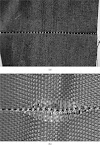Seam Strength
Seam strength is the force required to break the seam. Stitches are used to join the apparel component and seams give the shape of the apparel for wear. These two factors together and their performance properties add to the quality of the apparel products. Seam interrelate with the components of the fabric to ensure the best product stability. The quality seam contributes to the overall performance of the apparel in use. Poor quality seam makes apparel unsuitable even though the fabric may be of premium quality.
Along with testing seam strength, we can also calculate
1. Seam elongation
Their is one scale on machine near the clamp which can be use to measure elongation.
2. Seam efficiency
Seam efficiency = ( Seam strength / Fabric strength ) * 100
For thus we need to also calculate fabric strength.
3. Seam slippage
We can note down the reading at which the seam starts to open and it will give us seam slippage.
Seam strength can be measured by two standards –
A. British Standard
BS EN ISO 13935-1 (Strip method)
BS EN ISO 13935-2 (Grab method)
B. American Standard
ASTM D1683
Let’s see the procedure for BS EN ISO 13935-1 (Strip method)
• Preparation –
1. The seam samples were prepared according to the BS EN ISO 13935-1 method.
2. Each specimen of the fabric was cut in the warp and weft direction into 350 mm length and 100 mm width with seam sewn.
3. Make four cuts of 25 mm length at 10 mm distance from seam, as shown in figure.
4. For the seam strength testing five samples each of warp and weft was prepared.
• Testing –
1. Clamp a test specimen centrally so that its longitudinal central line passes through the centre point of the front edges of the jaw and the force is applied perpendicularly to the seam in the middle of the gauge length.
2. Gauge length is distance between two jaws which 200 mm.
3. Set the rate of extension to 100 mm/min.
4. After closing the upper jaw, avoid the pretension when adjusting the test specimen in the lower jaw, so that the fabric hangs under its own weight when the lower clamp is closed.
5. Stop the machine as soon as the seam breaks.
6. Record the of seam strength and the seam elongation.
7. Take the average of readings to get the seam strength.
• Precautions –
1. Avoid the readings of the test when rupture occurred
a) Fabric tear
b) Fabric tear at jaws (Jaw break)
2. Consider the readings when rupture occurred due to
a) Fabric tear at the seam
b) Breakage of sewing thread
c) Thread pull out
d) Or any combination of these













0 Comments
If you have any doubts, please don't hesitate to ask